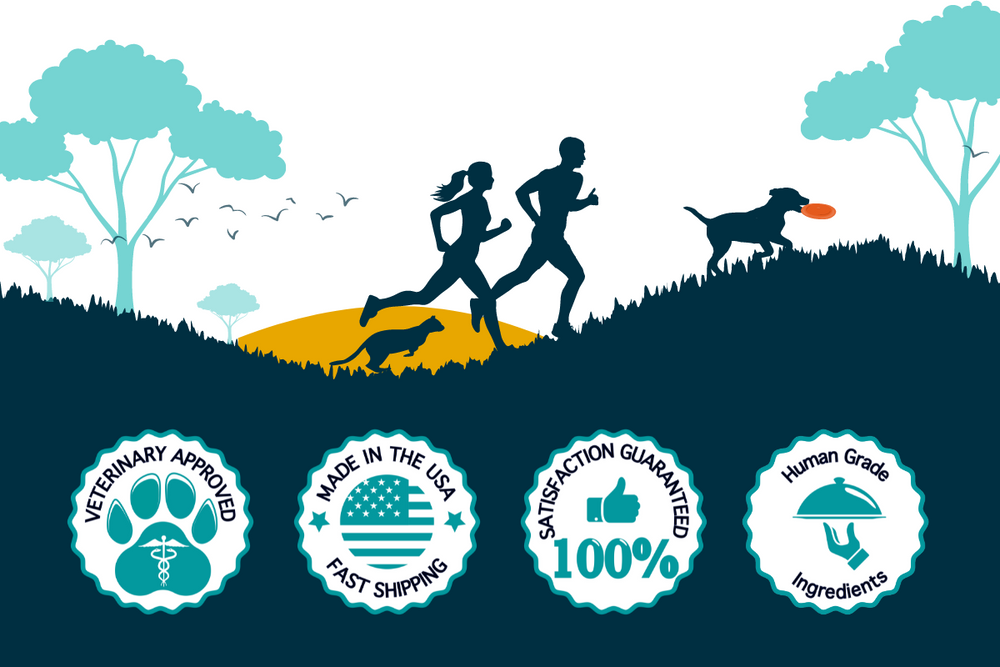Want your dog to run faster and more accurately? Not knowing your dog’s natural lead prevents you from training your dog’s weaker side, which can result in your K9 athlete to be slower and having more faults.
In this interview with Jessica Ajoux, you are going to learn the most important points about leads and using that knowledge to your advantage.
Watch the full interview live by clicking image below or keep scrolling to keep reading.
Introduction to Jessica
Jessic
Jessica has been doing agility since 2000 but began training before that. Her parents had to drive her to her first training classes and dog shows because she wasn’t driving yet. Agility is both her profession through UDA and her hobby and passion, what she would be doing for fun. Even in her off hours, she is still doing agility and talking about dogs.
Hallelujah, Jessica’s dog, paid us a visit. She is now a mommy, and she is so sweet.
When she was younger, Jessica lived in France with her family and spent a lot of time riding horses. She first learned about leads in the horse world, where there has been a lot of research done, but it applies to dogs as well, any four-legged animal that runs, in fact. It has a big impact on the handler’s understanding of how they can work with their dog more successfully.
Let’s Talk Leads
The lead refers to a pattern of footfalls that a dog has while running. Dog could be either walking, trotting, or running, depending on their speed. When they are "running", so in a canter or gallop, which feet hit the ground at which time affects which lead the dog is on.
In agility, it’s pretty simple. When a dog is running, he is either on his left or right lead. The more you know about leads, the better you can predict which way your dog is going. It helps you know which way they are turning, it helps you plan if you need to change their direction, and it helps you with specific agility to know which obstacle they could be thinking about. Is this obstacle a good thing or a bad thing; do you need to change their direction?
If the dog is on its left lead, then it is turning left. If a dog is on its right lead, then it’s turning right. Even if they are running in a straight line, they will be on one of their leads. They are going straight with the intention of going left or right. This makes sense with playing Frisbee with my dog Sasha. She always does better when the Frisbee curves right.
You can tell which lead they are on by watching how they are running. When a dog is running, depending on which front leg is sticking farther forward, that tells you which lead the dog is on. On their left lead, the left leg is slightly further forward; on their right lead, the right leg is slightly further forward.
The good news is you don’t actually have to watch the dog’s feet when in agility. You will be busy watching their eyes or the path they are traveling on. However, you can still know which lead your dog is on based on certain factors. The #1 thing that affects which lead the dog is on in agility is your position in relation to dog. If your dog is on the left side, that will affect the lead. If your dog is on the right side, that will affect the lead.
The thing to remember is your dogs are always trying to turn toward you, as if you are the sun and the dog is the planet trying to orbit around you at all times. If your dog is on your left, he will want to look toward you. That means he will be curling toward the right, which means it’s running on its right lead. But the easiest thing to remember is he will be curling toward you. If the next obstacle is away from you, you will have to do something extra to get the dog to turn away from you and switch leads.
As soon as the animal is able to run, they have a lead.
Jessica currently has eight-week-old puppies running all over the yard, and you can see their leads. Us recognizing it is something we need to train ourselves to do.
A dog does switch leads naturally when they’re running. If they’re chasing something, they will run and cut directions, making lead changes all the time. You can affect that as well. A basic foundation exercise is to get them to turn away from you. If the handler is on the dog’s right-hand side, the dog is thinking toward the handler, so in this case, thinking right.
To get them to turn away from you they will change leads. Let’s use the example of a tunnel. Tunnels can dictate which lead your dog is on because they have to go in a specific direction. To us, it might look like a tunnel is right in front of a dog, but they are often not looking straight in front of them; they are looking toward the handler.
Let’s say the entrance to the tunnel is right in front of the dog, and it’s curving right. If the handler is on the right-hand side of the dog, it’s easy for the dog to head straight into the tunnel because it wants to be on its right lead to look toward the handler and to curve into the tunnel.
However, if we put the handler on the left-hand side, it’s more difficult. Experienced dogs don’t look like they’re struggling with this, but younger less experience dogs will struggle. The dog naturally wants to think toward the handler, using its left lead, thinking toward the left. The tunnel is forcing them to turn the right, which is away from the trainer. As that dog goes into the tunnel, they don’t want to go to the right because the handler is on the left side. They have to understand the handler is on the left, but I’m being forced to use my right lead.
Here’s another more complicated tunnel example. Let’s say the dog is having to go up and left to enter the tunnel, which curves up to the right. The handler is on the right-hand side of the dog. If we want them to go into this tunnel, the dog needs to turn left to get in, away from the handler. Note that the handler wants to keep running past the tunnel. The dog is then thinking to the right. They have to switch to their left lead to get into the tunnel and then switch back to the right lead quickly to follow the shape of the tunnel, which they will stay on once they leave the tunnel and see their handler on the right side of them.
o If this handler keeps running straight, the dog will run right by the tunnel because they need to be told about the direction change. It takes the dog more time because they must make a lead change away from the handler.
o If the dog has to change leads, it’s going to take them a split second longer to decide and then to execute. You have to see that moment as the handler.
If a dog is heavily right-pawed versus left-pawed, they can have difficulty, more so in jumping. They will be comfortable jumping to the right but add a wide turn when jumping to the left. It’s like how when you’re right-handed, writing with your left hand looks pretty terrible in comparison.
When Jessica was on a water polo team in high school, they drilled on both hands so both hands could catch the ball depending on where you were positioned in the pool. The more the dog can switch between the leads, just like how Jessica could switch hands in water polo, the better.
An incredible example happened during the WAO Games Finals in the Netherlands during the finals with Perry and a dog, Verb who won the gold medal. There was a straight tunnel in the gamble line, which the handler couldn’t cross over.
A straight tunnel does not force a dog to change leads, so it’s even more likely that the dog will be thinking about coming toward the handler.
The gamble went into the tunnel out to the jump and back to another jump. But the handler couldn’t cross the line. What happened was when the dog goes into this straight tunnel, they want to curl to the left toward the handler across the gamble line. So they had to get the dog to turn away from the handler.
There is a second lead puzzle in this. Even though this jump series looks like a straight line, that’s not necessarily what happens. While the dog is jumping this jump so far away from the handler, he is on his right lead thinking toward the handler. The next jump was left from the first jump, so the dog could easily run by that second jump because they are thinking to the right. They need to make a lead change to get to that second jump. The handler would have to use a verbal cue or something like that to get them to do that necessary lead change in time.
You would plan ahead for something like this during your course walkthrough and apply this knowledge here so that you as the handler are ready to cue them when necessary.
Developing Lead Skills
The first thing to do is to identify if a dog has a strong preference to turn one direction or the other. Another big thing is to be aware of it. People have preferences, too. If you are always working with your dog on the left, which typically happens in obedience, then your dog will curl toward the right. The handler tends to overwork one side. Make a conscientious effort to train anything on both sides so the dog develops the ability to turn in both directions.
The more Jessica does agility, the more she is seeing how the most successful agility dogs are the ones that can switch leads quickly. It’s not about how speedy they are; it’s about how well and easily they can transition and make quick adjustments, especially for jumping.
Jessica’s mom loved figure skating, so they always watched them during the Olympics. The figure skaters who looked fluid and as if they were floating were the most successful. This translates to agility in that if you can feel that your dog is having a harder time on one side than the other, it just doesn’t go as smoothly. If it feels smooth, they are moving more quickly, and that’s how you know it’s happening more easily for them. It certainly takes practice to recognize this.
Let’s talk about tapping your head with your right hand and rubbing your belly with your left hand. Maybe that works for you. Could you do it the other way, tapping your head with your left hand and rubbing your belly with your right? Work both sides and practice equally. That is the key.
Dogs pattern somewhat quickly. It’s muscle memory. And the feeling of the exercise becomes a memory as well. Make sure they can run on both their left and right leads, and that they are aware of that.
Dog agility is a team sport. Even if you have trained your dog to be functional on both leads, some things are still harder.
Hallelujah, switching from left to right on some jumps, can be more difficult for her. On some of those more difficult backside slices with multiple lead changes on one jump, if Jessica knows those take her a little bit more time, she can do something about it while on the course. She can empathize in the moment and stay more connected in that moment during that jump.
Clearly Jessica’s psychology degree from Princeton is kicking in here.
Contact Jessica
● UnitedDog Agility on Facebook, Instagram, YouTube










